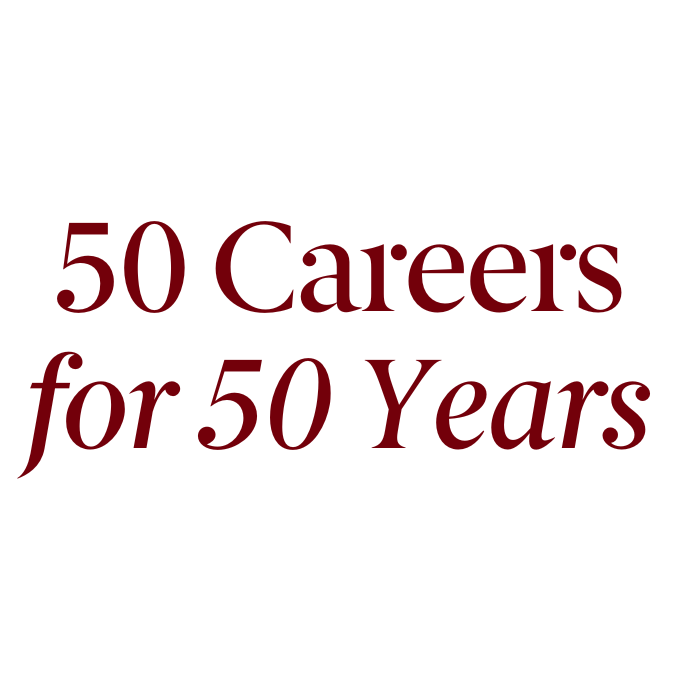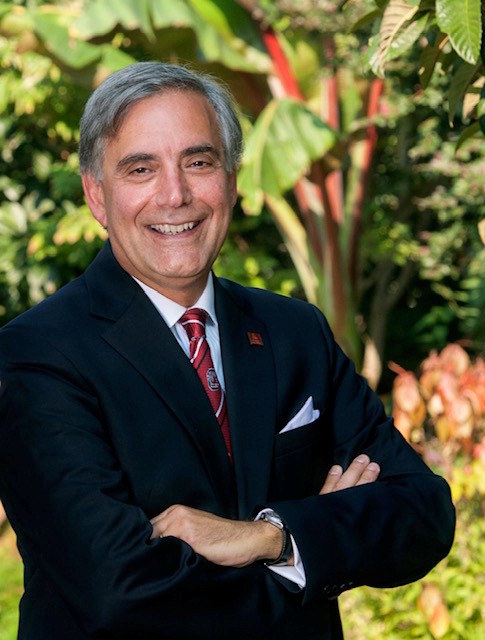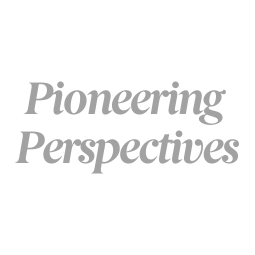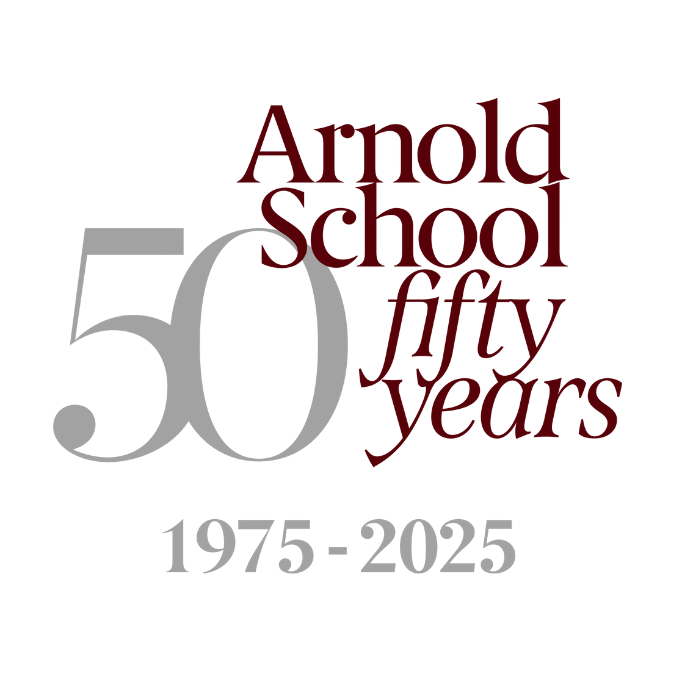
50 Careers for 50 Years
Fifty public health alumni reflect on their educational journeys and the impacts they’ve made across communities, countries, and the world.
October 8, 2025 | Erin Bluvas, bluvase@sc.edu
Harris Pastides is most often associated with his 11-year tenure as President of the University of South Carolina. He’s known for his administration’s achievements: $1 billion capital campaign; No. 1 ranked Honors College among public universities; 47 degree programs gaining top national academic status. And for the way he came out of retirement during a moment of crisis (the COVID-19 pandemic) to rescue his beloved university by serving as interim president while we searched for new leadership.
Few keep it top of mind how he came to the university: A longtime New Englander recruited to leave a successful chairship and thriving research program in cancer epidemiology at the University of Massachusetts Amherst to lead a promising school of public health nearly 900 miles South. Pastides may be most known for his role as USC President, but his five years as Dean of the Arnold School were incredibly impactful for both the school and Pastides’ own career as his accomplishments during this tenure paved the way for growth and advancement at the Arnold School as well as the university as he rose the ranks to lead it.
The child of immigrants who raised him in the Queens borough of New York City, the teenage Pastides found himself interested in two areas: health care and issues of justice. As a premed student at the University at Albany, he came across a brochure about careers in public health.
“I thought, ‘that sounds like me – I like medicine, and I like the public,’” Pastides recalls. “Epidemiology felt like the best fit because – along with its kissing cousin, biostatistics – it was the most medical and quantitative.”
As his bachelor’s graduation approached, Pastides considered dual degrees in medicine and public health. Yale University’s public health program came back with a generous financial package whereas medical school would have put the first-generation college student into mountains of debt.

“While earning my Master of Public Health, I fell in love with research, and I met my wife, Patricia, so it was the best decision I could have made,” Pastides says.
Not long into the program, he knew he would go on to complete his Ph.D. as well. His advisors encouraged him to simply move into the master’s and doctoral programs, which focused on epidemiology, without completing the MPH. But Pastides could already envision a career not only in research but one that was also focused on teaching students and preparing them for careers in public health. He knew it would be important to fully understand the practitioner role, and so he completed all three.
When Pastides graduated in 1980, he had two compelling offers for his first academic appointment. One was at what he now calls “the other USC” – a research-heavy role with a cancer center in LA that allowed very little time for educating students. The other was a more balanced position at the University of Massachusetts Amherst that afforded more time for teaching and kept the young couple closer to family.
When Pastides achieved tenure in 1993, he also took on the chair position for his
department – one of few in the country (with USC being one of them) that combined
epidemiology and biostatistics together. His career and family, which included two
kids, were happy and settled.
“I remember the day that George Terry, USC’s then-Dean of Libraries and chair of the search committee for the university’s school of public health dean, called,” Pastides says.
Winona Vernberg, the school’s longest serving dean, had retired, and Dianne Ward was filling in as interim while USC Provost Jerry Odom looked for the school’s next leader.
“It was February, and I could see it was sleeting as I looked out my office window,” he says. “George’s offer to ‘just come down and enjoy a warm weekend’ sounded pretty good right then.”
Pastides was surprised by how quickly he fell in love with USC – the campus, the Horseshoe and the opportunity to take a good school of public health and make it one of the best in the land. He and Patricia moved their family to the south, and she took on a role supervising the Richland County Health Department.
On his first day, Aug. 1, 1998, Pastides parked in the spot reserved for the dean and was quickly – but politely – told by long-time facilities staff member Clara Stewart that he couldn’t park there because it was being saved for the new dean.
“I told Clara I was the new dean, and she gave me a hug to welcome me to the school,”
Pastides says. “That moment on my very first day was just so symbolic of the culture
I would encounter throughout my time at USC.”
Pastides only had a few years as dean before university leadership began asking him to take on higher-level positions, but – almost as if he knew he didn’t have very long – he approached his role with an energy and foresight that would set the stage for decades of growth. Looking back, Pastides summarizes his contributions as possible due to his ability to bring two major elements to the table: a healthy investment pool (first from his negotiated start-up package and later from Norman J. Arnold’s transformative gifts) and the selection of a strategic focus that the school could all get behind.
“You can have great ideas, be very ambitious, and have high energy, but if you don’t have resources, it won’t matter,” Pastides says. “USC gave me a very generous start-up package that allowed me to hire more faculty and invest more in our programs and departments, and that made all the difference.”
Early on in his tenure, Pastides convened the department chairs and other elected faculty leaders for strategic planning – first offsite and then continuing forward back on campus.
“Everyone was doing well in their respective areas and wanted more funding and support to grow, which made complete sense,” Pastides says. “But what I pointed out to them was that the best schools of public health and the best universities got their stature by being the best at something – not by being the best at everything.”
They put their heads together and realized that physical activity would be the perfect area to prioritize. The school already had a head start in terms of research, programs, and productivity in this area and was one of the few schools of public health in the country with an exercise science department.
“We agreed we would invest in everything, but especially in recruiting people who would focus on physical activity within their discipline, regardless of the department,” Pastides says.
With much-needed start-up funds available, the school was able to attract top faculty. In total, Pastides estimates they hired around 20 new faculty members thanks to the resources provided by the Provost Office. Columbia’s affordability, good schools, warm weather, and budding restaurant and outdoor scenes also helped them recruit candidates away from more expensive, crowded cities. Some of the most promising as well as most established public health researchers began choosing USC.
“Strength begets strength,” he says. “And that’s how USC has become the kind of place where those types of top scholars want to be.”

The new approach resulted in a cultural shift for the six departments. They each took the initiative to come up with their own proposals for how to grow and move forward. Pastides’ response? “Absolutely! What do you have in mind?”
This proactive mindset extended to the Department of Communication Sciences and Disorders – a field not traditionally associated with schools of public health and one that, at USC, had historically been known for its prowess in turning out exceptional speech-language pathologists, particularly those working with children. Pastides turned to this department – the least research-oriented of the bunch at the time – and asked them how they saw themselves keeping pace with this burgeoning school of public health.
“Elaine Frank was chair at the time, and I give her and the other faculty, like Hiram McDade and Al Montgomery, so much credit for putting their shoulder to the wheel,” he says. “They recruited top notch faculty like our current Vice President for Research, Julius Fridriksson, and the department quickly became world class for their research and funding.”
Pastides and his team also infused this strategy into the school’s centers and institutes. With fortuitous timing, USC’s CDC-funded Prevention Research Center was just wrapping up their first funding cycle and had the opportunity to refine their focus for the next five years. Exercise science professor Russell Pate stepped up to lead the development of physical activity training for public health professionals – creating courses that continue to be offered today and setting the stage for numerous impactful projects, including the PRC’s current core program, Faith, Activity and Nutrition (FAN). As leaders in the field, the school hosted CDC-supported physical activity-focused conferences each year.
“Before we knew it, we were hitting on all cylinders,” Pastides says. “Academics are often alleged to have their nose in the ground – very good at what they do but very narrow and not living in the real world. If you want to build a great academic community, you need a formula and a strategy, and then you need to go to work.”
One memorable milestone was when the school reached $6 million in competitive grant
awards for a single year – a small amount compared to today’s $54.2 million but still
the highest-funded academic unit at the university at the time. Alongside this rapid
growth using traditional channels, however, one of the biggest landmark events in
the school’s history was slowly coming to fruition.
It started with a conversation over a cup of green tea in an office with stained blue carpet on the first floor of the old Health Sciences Building. Pastides’ guest was Norman J. Arnold, a local businessman and pancreatic cancer survivor. His initial prognosis estimated that the then-fifty-three-year-old had just six months to live. Giving credit to the lifestyle behaviors promoted by public health, Arnold lived another 34 years.
Arnold was 69 when he approached the brand-new dean about ways he might help advance the field by contributing to the school. Still, Pastides had trouble understanding why someone who was not a public health professional, not a public health graduate, not even an alumnus of USC, would want to be so generous to this school in particular.
“To help people,” Pastides remembers Arnold saying. “This gift isn’t intended for you specifically. It is for the people of South Carolina and beyond. You’re the type of people and the type of school who are open to nonmedical forms of prevention, like diet and exercise, and you are the ones who can make this type of impact.”
Their conversations continued for the next year, with the two becoming close, like father and son. Then one day, Arnold called and said, “I’m ready.”
But first he wanted to meet with the president, John Palms, and the three had lunch together.
“Norman did something only a shrewd businessman would think to do,” Pastides says. “He said he would make an initial $10 million gift now and then donate another $7 million down the road, but he wanted the university to match his gifts, and he wanted them to contribute the funds that we needed to complete the Public Health Research Center. Norman got both.”
In the year 2000, the Norman J. Arnold School of Public Health became the third school of public health in the nation and (and the first at a public institution) to be a named academic unit. It was also the second named school at USC – following the Darla Moore School of Business by just two years and preceding the university’s three other named schools by more than 20 years.
“The symbolic investment of naming the school was even more important than the monetary
impact,” Pastides says. “Even internally, it made our faculty look at themselves differently.
Sometimes you think self-confidence is self-generated, but it’s really the outside
world that gives you your self-esteem. Norman’s gift really changed everything.”
The Arnold School’s size, reputation, and impact were growing rapidly, and Pastides’ own star rose in parallel. Just four years into his role as dean, President Andrew Sorenson asked him to become Vice President for Research and Economic Development. Not ready to leave public health, Pastides held both roles for a year until he had to make a hard choice and handed the reins to Donna Richter.
He spent another five years as vice president, during which time he was able to continue looking out for the Arnold School – not that it was favoritism. When the time came to allocate the Discovery Building to a deserving college, the Arnold School’s continued growth and success made it the clear choice.
“Every day, the Arnold School was proving what it could do and needed more space to do it,” he says. “Honestly, they could have used the whole block.”
When Pastides became USC President in 2008, he was even further separated from his treasured Arnold School – not that he stopped (quietly) rooting for it. Though the school eventually ended up on the opposite end of campus from his home on the Horseshoe, he kept a close watch on its progress under the capable hands of its faculty and leadership.
Pastides retired in 2019 and enjoyed two slower years before being called back in to service as interim president in 2021. He’s held on to his Distinguished Professor Emeritus and Distinguished President Emeritus status since 2022 – happy to pass the torch to Michael Amiridis, who became the university’s 30th president.
Now firmly in his (second) retirement, Pastides spends his free time advising Amiridis and the Board of Trustees. He also serves as the only non-physician elected to the American Medical Association’s Board of Trustees and recently wrapped up a term chairing the Advisory Board of the Council for the International Exchange of Scholars, which administers the Fulbright Scholar Program (international students/exchanges have always been a passion for him). He and Patricia also enjoy spending time with their two children and three grandchildren.
Pastides is an inaugural recipient (among just seven Fulbright alumni) of the Global Changemaker Award (2016) and the winner of the Ellis Island Medal of Honor (2017). He has also received the SC Urban League Whitney M. Young Award (2017) for his efforts to promote civil rights and equal opportunity.
Looking back on his time as dean of the Arnold School and its subsequent growth and success, Pastides can summarize his contributions in two words: funding and strategy. He’s proud to have kindled the fire that propelled the school to its current stature.
“We shot up so quickly back in those days, and once we became more established, we could build more methodically,” Pastides says. “Over the past 50 years, we’ve gone from being a very fine regional school of public health to a highly respected global school of public health, and I’m so proud of what we’ve done.”

Fifty public health alumni reflect on their educational journeys and the impacts they’ve made across communities, countries, and the world.

Each month, we're telling the stories of alumni, faculty, and leaders whose unique perspectives shed light on the Arnold School across its five-decade history.

Join us as we celebrate the school’s 50th anniversary with guest speakers, symposia, feature stories, and anniversary events for students, alumni, faculty, staff and friends.